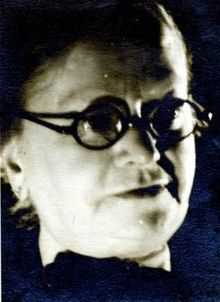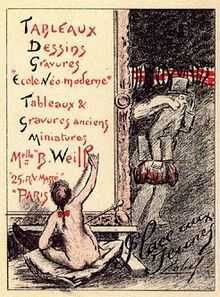Berthe Weill


Berthe Weill (Paris 1865 – 1951)[1]:11 was a French art dealer who played a vital role in the creation of the market for twentieth century art with the manifestation of the Parisian Avant-Garde. Although she is much less known than her well-established competitors like Ambroise Vollard, Daniel-Henry Kahnweiler and Paul Rosenberg, she may be credited with producing the first sales in Paris for Pablo Picasso[2]:26 and Henri Matisse[2]:26 and with providing Amedeo Modigliani with the only solo exhibition in his lifetime (see poster advertising the exhibition).
The impressive list of artists who made their way through her gallery and into the canon of modern art continues with names such as Raoul Dufy, André Derain, Maurice de Vlaminck, Diego Rivera, Georges Braque, Kees van Dongen, Maurice Utrillo. Her role was also important in the early exposure and sales of women painters such as Suzanne Valadon, Emilie Charmy and Jacqueline Marval.[3]
In 1933, Weill published her memoirs, an account of thirty years as an art dealer, from which many historical renditions quote.[4] Her gallery lasted until 1939 and notwithstanding the number of luminary artists that passed through her gallery, she remained poor and destitute her whole life and after her death was almost forgotten.
Recently, interest in Berthe Weill has become more significant.[2] In 2007, Picasso’s portrait of Berthe Weill (1920) was designated a French national treasure[5]:11. In 2009 her memoirs (1933) were republished [1] and a compilation of her gallery exhibitions;[5] in 2011 the first study dedicated to her life and dealership was published.[6] In February 2012, the City of Paris decided to put a memorial stone at 25 rue Victor Massé (paris 9e) where Berthe Weill opened her first gallery in 1900.[7]
Life and career
Esther Berthe Weill was born in Paris into an Alsatian Jewish lower middle class family, one of seven children. As her parents were of modest means, Weill was placed as an apprentice in Mayer’s antique shop where she learned the business of the trade and acquired considerable knowledge, in particular, of eighteenth century engravings. This experience would serve her well as she also met collectors, writers and other dealers.
Upon Mayer’s death, she opened a little shop in association with one of her brothers, but it did not last long (1897-1900). Under the influence of Roger Marx, a renowned art critic, she became interested in the art of the new young painters.[8]:31
In 1900, not long after Picasso arrived in Paris, she bought and sold several works producing Picasso’s first sales in Paris.
In 1901, with the help of Mañach, a young Spanish painting broker, and 375 francs, money earmarked for her dowry, she inaugurated “Galerie B. Weill” and dedicated it as a place for the young painters “Place aux Jeunes”, much to the chagrin of her family and the widow of Mayer, who felt that discovering new artists was a risky business. In the event, her gallery lasted until 1939.
In 1946, many painters who she had championed over the years came together and held an auction of their donated art work, the proceeds went to support Berthe Weill so she could live in some comfort for the last years of her life[5]:11.
In 1948, the Republic of France recognized her as a Chevalier de Légion d’Honneur, for her contribution to Modern Art[5]:11.
In 1951, at the age of 86, Weill died. Although she was recognized at some level during her lifetime, she was left with a legacy of being either misunderstood or relegated to the footnotes of historical accounts of the period, until recent renewed interest emerged.
Artists
Picasso, Matisse, Derain, Vlaminck, Marquet, Manguin, Camoin, Raoul Dufy, Diego Rivera, Braque, Friesz, van Dongen, Utrillo, Puy, Metzinger, Modigliani, Rouault, Marie Laurencin, Suzanne Valadon, Emilie Charmy, Kisling, Flandrin, Léger, Pascin...
Collectors

- Adolphe Brisson, Literary Critic for Temps
Picasso’s first sales in Paris were three pastels on canvas depicting bull-fighting scenes, which Weill sold to him in 1900.
- Arthur Huc, Director of La Dépêche de Toulouse. Weill sold Le Moulin de la Galette (1900) to Arthur Huc. According to John Richardson, Huc was "one of the most progressive collectors of the day”. Later this painting was bought by Justin Thannhauser who donated it to the Guggenheim Museum (NY) [9]:168.
- Franz Jourdain, Architect of the Samaritaine Department Store, first president of the Salon d'Automne ; in 1902, Weill sold a Marquet to him [8]:31.
- André Level, Head of the consortium of investors who, in 1904, began forming the Peau de l'Ours art collection of twentieth-century art. In 1914, it was sold at auction and was notable for its "phenomenal financial success". "Weill claimed that three-quarters of the items in the collection were purchased from her gallery. Even if she exaggerated, there is no doubt that Level bought from her on a regular basis[2]:26-27[4]:194.
- Gertrude and Leo Stein, American expatriates living in Paris who played a pivotal role in promoting and collecting avant-garde art
- Olivier Saincère, Counsellor of State and future secretary general of the Élysée under Raymond Poincaré, one of Weill's first collectors.
- Gustave Coquiot, French writer and art critic, collector of Maurice Utrillo.
- Sergei Shchukin, Russian collector from Moscow[9]:389-393.
References
- ↑ 1.0 1.1 Weill, Berthe, "Pan ! Dans L’œil ! Ou trente ans dans les coulisses de la peinture contemporaine 1900-1930", L’Échelle de Jacob, 2009 (Préface by François Roussier de la Tronche)
- ↑ 2.0 2.1 2.2 2.3 FitzGerald Michael, "Making Modernism: Picasso and the Creation of the Market for Twentieth-Century Art", Farrar, Straus and Giroux, New York", 1995, ""
- ↑ Perry Gill. “Women Artists and the Parisian avant-garde: Modernism and 'feminine' art, 1900 to the late 1920s", Manchester University Press, Manchester and New York”, 1995
- ↑ 4.0 4.1 Weill, Berthe. "Pan ! Dans L’œil! Ou trente ans dans les coulisses de la peinture contemporaine 1900-1930", Lipschutz, Paris 1933
- ↑ 5.0 5.1 5.2 5.3 Sanchez, Pierre, "Les expositions de la Galerie Berthe Weill (1901-1942) et de la Galerie Devambez (1907-1926) Repertoire des artistes et liste de leurs œuvres", II, L’Échelle de Jacob, Dijon, 2009
- ↑ Le Morvan Marianne,"Berthe Weill 1865-1951 La petite galeriste des grands artistes", L'Écarlate, Orléans, 2011
- ↑ Decision by the Council of Paris to install a "plaque commémorative" at 25, rue Victor Massé
- ↑ 8.0 8.1 Elderfield, John, "Fauvism: The “Wild Beasts” and Its Affinities", Exh. cat., The Museum of Modern Art, 1976
- ↑ 9.0 9.1 Richardson John, "A Life of Picasso: The Early Years, Vol. I, 1886-1906", Random House, 1991
External links
- Berthe Weill: Galériste à Montmartre. Biography by Françoise Job, 2005
- Decision by the Council of Paris to install a "plaque commémorative" at 25, rue Victor Massé